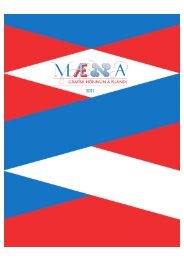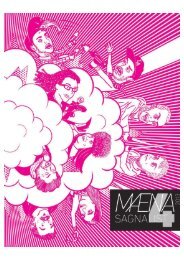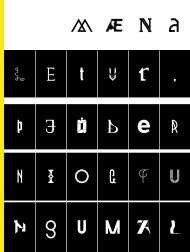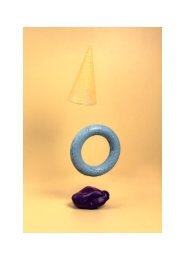Create successful ePaper yourself
Turn your PDF publications into a flip-book with our unique Google optimized e-Paper software.
84.<br />
Turning Tide<br />
by JEFF RAMSEY<br />
One of the most important books that I own<br />
is Dieter Roth’s Die Blaue Flut (The Blue<br />
Tide).(1) Published in 1967, Die Blaue Flut<br />
originates from DR’s American diary when he<br />
was teaching in Providence, RI. The book is<br />
divided into four parts, listed on the contents<br />
page as:<br />
1 the blue tide (manuscript of the first part)<br />
2 the blue tide (1. reproduction of the first part)<br />
3 a look into the blue tide (English-language<br />
manuscript of an excerpt from “the blue tide<br />
second part”)<br />
4 the blue tide second part:<br />
the blue red green black grey yellow brown tide<br />
or<br />
the brown mess (manuscript)<br />
Part 1 is DR’s 1966 daily diary. Typewritten at<br />
the top of each page are the year, month, and<br />
day, a countdown of days to come, and other<br />
information like holidays and birthdays.<br />
Onto these sheets he has also added typed<br />
and handwritten texts, along with drawings<br />
and diagrams.(2)<br />
Part 2 is this same diary typeset in Futura.<br />
However, now there are no drawings or<br />
handwritten text. All of the words are<br />
lowercase and the same point size – most<br />
are set in bold weight — with all of the<br />
punctuation spelled out in regular weight.<br />
These texts are aligned left and begin at the<br />
top left of the page in what can be described<br />
as a default placement.(3)<br />
Part 3 is the shortest and consists of a<br />
selection of drawings and handwritten texts<br />
taken from the original manuscript of the first<br />
chapter, translated from German to English,<br />
with no reference made to the dates and<br />
other practical information included in the<br />
previous sections.(4)<br />
Part 4 returns to the entire diary of the first<br />
manuscript and is again typewritten. As in<br />
section 1, all information begins at the top<br />
left of the page, left aligned. No handwritten<br />
elements exist in this section. However,<br />
here DR elaborates on his original sketches,<br />
by including texts that comment on or<br />
“complete” the manuscript of the first part.(5)<br />
(Re) Turning Tide:<br />
A Working Method<br />
What interests me about this book,<br />
beyond its visual beauty and conceptual<br />
muscle, is the inseparability of its form<br />
and content. Die Blaue Flut, unlike a lot<br />
of (typo)graphic design and art, is not the<br />
result of content which has been as-<br />
signed a form, but rather, is an adept<br />
combination of content and a process<br />
which arrives at a singular form. It is<br />
its own process of becoming. This quality<br />
is shared by the kinds of projects that I am<br />
attracted to and that I model my practice<br />
on. Whereas much contemporary design<br />
concerns itself with surface over depth,<br />
and illusion over substance, I prefer the<br />
sincere commitment to material (content<br />
and process) over the fleeting whims<br />
of fashion. Because, for me, the stuff of<br />
everyday life is the only stuff to work with.<br />
Image captions (1–5)<br />
Die Blaue Flut (the blue tide) reproduction<br />
of first edition, edition hansjörg mayer,<br />
Stuttgart 1967 and 3 original manuscripts,<br />
Markgröningen, Providence, Reykjavik 1966–<br />
1967, 632 pages, offset, 23 x 17 cm, stitched,<br />
softback, printed by Staib + Mayer, Stuttgart.<br />
edited by hj. mayer and d. rot, published by<br />
edition hansjörg mayer, Stuttgart, London,<br />
Reykjavik 1973 in an edition of 1000.<br />
1<br />
2 3







